Trouble Shooting Tips
To replace dispenser:
• shut off electricity to dishwasher,
• remove outer door panel assembly,
• disconnect wiring to the actuator,
• remove the six screws,
• remove the dispenser,
• replace and reinstall screws,
• rewire actuator.
Check the Following
1. Fuse (blown or tripped).
2. 120 VAC supply wiring connection
faulty.
3. Electronic control board defective.
4. No 12 VAC power to control.
5. Motor (inoperative).
6. Door switch (open contacts).
7. Door latch not making contact with
door switch.
8. Touch pad circuit defective.
9. No indicator lamps illuminate when
START or OPTIONS are pressed.
1. Motor (bad bearings).
2. Motor stuck due to prolonged
non-use.
1. Improper voltage.
2. Motor windings shorted.
3. Glass or foreign items in pump.
1. Heater element (open).
2. Electronic control board defective.
3. Wiring or terminal defective.
4. Hi-Limit thermostat defective.
1. Latch mechanism defective.
2. Electronic control board defective.
3. Wiring or terminal defective.
4. Broken spring(s).
5. Defective actuator.
1. Drain restricted.
2. Electronic control board defective.
3. Defective drain pump.
4. Blocked impeller.
5. Open windings.
6. Wiring or terminal defective.
1. Water supply turned off.
2. Defective water inlet fill valve.
3. Check fill valve screen for
obstructions.
4. Defective float switch.
5. Electronic control board defective.
6. Wiring or terminal defective.
7. Pressure Switch Stuck.
1. Drain hose (high) loop too low.
2. Drain line connected to a floor drain
not vented.
1. Detergent allowed to stand too long in
dispenser.
2. Dispenser wet when detergent was
added.
3. Detergent cover held closed or blocked
by large dishes.
4. Improper incoming water
temperature to properly dissolve
detergent.
5. See "Detergent cover will not open."
Always disconnect the dishwasher from the electrical power source before adjusting or
replacing components.
Personal Injury Hazard
Heater
Refer to the cycle chart on the reverse side to
determine when the heater is on during the
wash cycle. The heater cycles ON and OFF for
brief periods during the drying cycle.
Voltage checks of the heater should be made in
the dry portion of the service test mode.
The drain hose must have a loop at a
minimum
height of 32 inches
in order to insure proper
drainage.
Pump Assembly
The pump assembly is driven by a synchronous
motor. The motor drives a pump which supplies
100 percent filtered water
Draining is accomplished by using a small
separate synchronous drain pump mounted to
the side of the sump. The drain pump is
connected to the main pump by a small rubber
hose. The drain check valve is located at the
discharge end of the drain pump. The drain hose
is attached by a clamp to the discharge end of
the drain pump.
Detergent and Rinse Aid Dispenser
The detergent and rinse aid dispenser is a one
piece component consisting of a molded
detergent cup and a built-in rinse aid dispenser.
The detergent cup has a spring loaded cover
and the rinse aid dispenser has a removable
cover.
Liquid rinse aid is added to the dispenser up to
the fill line indicator. The amount of rinse aid
released can be adjusted by turning the arrow
indicator from one, being the least amount, to
four, being the greatest amount.
Remedy
1. Replace fuse or reset breaker.
2. Repair or replace wire fasteners at
dishwasher junction box.
3. Replace control board.
4. Replace control board.
5. Replace motor/impeller assembly.
6. Replace latch assembly.
7. Replace latch assembly.
8. Replace console assembly.
9. Replace console assembly.
1. Replace motor assembly.
2. Rotate motor impeller.
1. Check voltage.
2. Replace motor/impeller assembly.
3. Clean and clear blockage.
1. Replace heater element.
2. Replace control board.
3. Repair or replace.
4. Replace thermostat.
1. Replace dispenser.
2. Replace control board.
3. Repair or replace.
4. Replace dispenser.
5. Replace dispenser.
1. Clear restrictions.
2. Replace control board.
3. Replace pump.
4. Check for blockage, clear.
5. Replace pump assembly.
6. Repair or replace.
1. Turn water supply on.
2. Replace water inlet fill valve.
3. Disassemble and clean screen.
4. Repair or replace.
5. Replace control board.
6. Repair or replace.
7. Repair or replace.
1. Repair to proper
32-inch minimum
height
.
2. Install air gap at counter top.
1. Instruct customer/user.
2. Instruct customer/user.
3. Instruct customer/user on proper
loading of dishes.
4. Incoming water temperature of
120°F is required to properly
dissolve dishwashing detergents.
Symptom
Dishwasher will not operate when
turned on.
Motor hums but will not start or run.
Motor trips out on internal thermal
overload protector.
Dishwasher runs but will not heat.
Detergent cover will not latch or
open.
Dishwasher will not pump out.
Dishwasher will not fill with water.
Dishwasher water siphons out.
Detergent left in dispenser.
Standard Dry Air Flow
The heated, moist air leaving the dishwasher
through the console vent causes drier air to be
drawn into the unit by way of intake vents located
at the bottom of the door.
020905
The water on the dishes is evaporated into drier
air and the venting process continues. The
heating element is turned ON and OFF during the
entire drying cycle.
Product Specifications
Electrical
Rating ...................................120 Volts, 60Hz
Separate Circuit..15 amp min.- 20 amp max.
Motor (Amps) ................................... 0.6 - 0.9
Heater Wattage .......................... 475 - 630W
Total Amps (load rated) .......................... 7.0
TempAssure .............................. 135°F ±5°F
(60°C±3°C) [with outer door in place]
TempBoost ................................ 140°F ±5°F
Heated Wash/Heated Rinse
Hi-Limit Thermostat ............... 200°F (93°C)
Water Supply
Suggested minimum incoming water
temperature ............................ 120°F (49°C)
Pressure (PSI) min./max. .................. 20/120
Connection (NPT) .....................................
3
/8"
Consumption (Normal Cycle) ......................
.......................................... 5.2 - 5.6 U.S. gal
Water valve flow rate (U.S. GPM)............ 0.9
Water recirculation rate (U.S. GPM) ..............
................................................. approx. 5.28
Water fill time ................................... 36 sec.
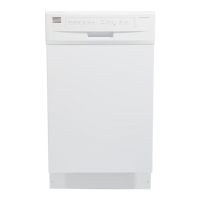
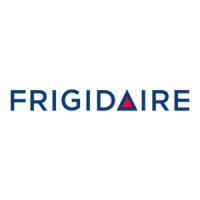

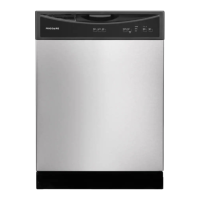


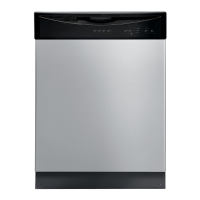
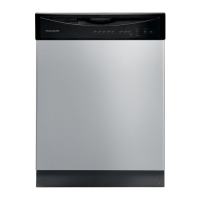
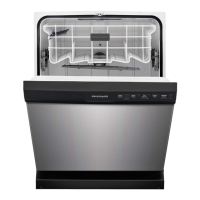

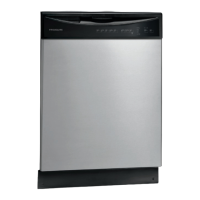

